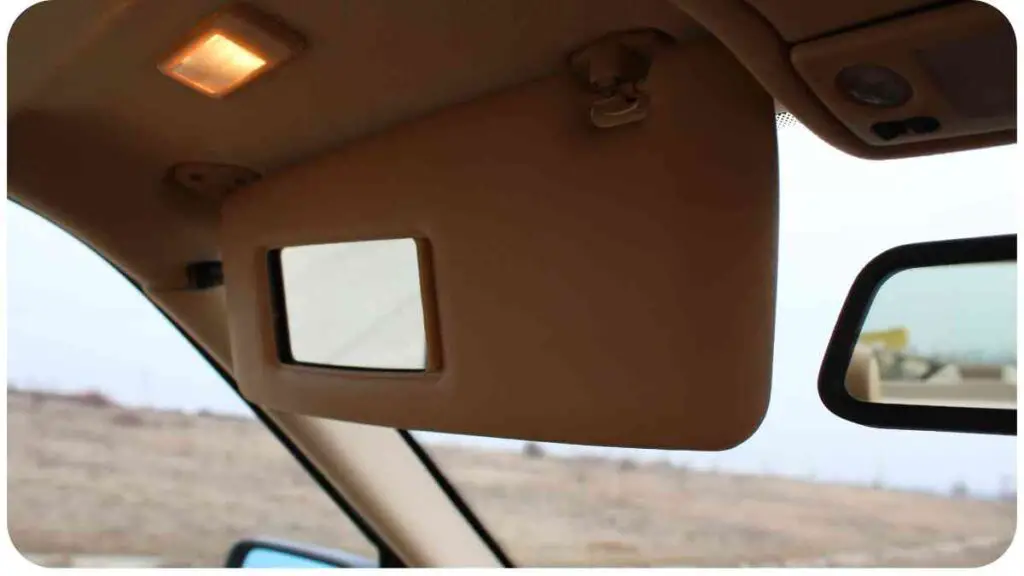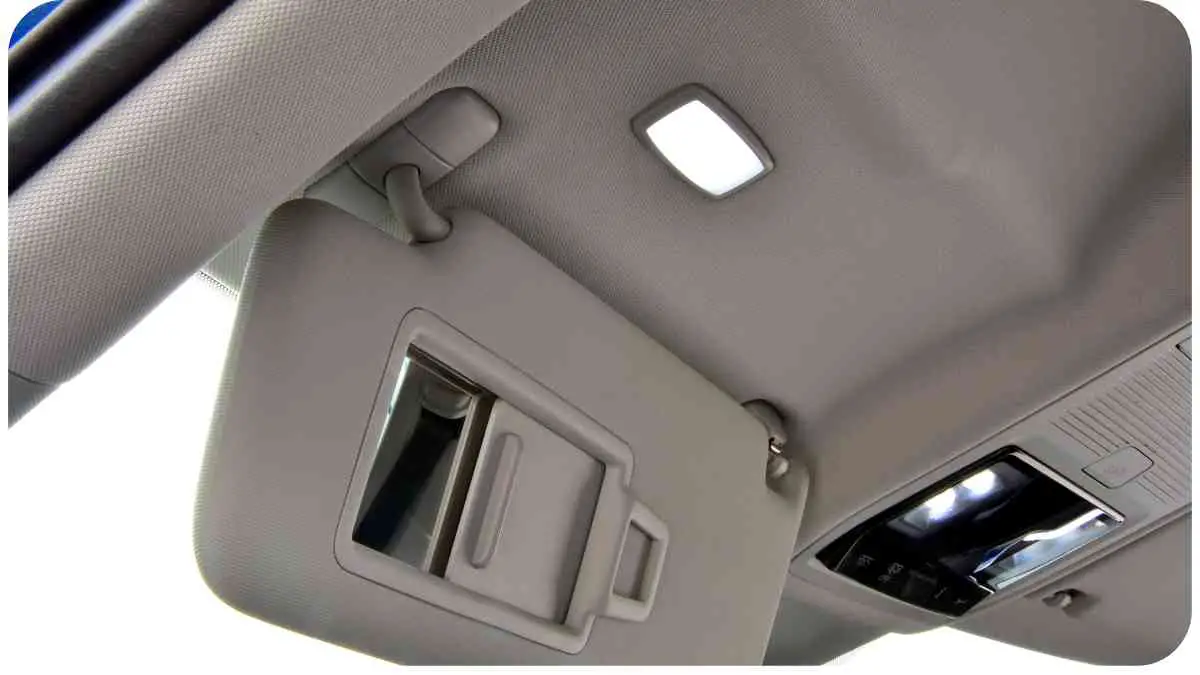Are you tired of your car’s sun visor falling down at the most inconvenient times? Don’t worry; you’re not alone. Many car owners have encountered the frustrating problem of sun visors that refuse to stay in place.
In this comprehensive guide, we will explore the reasons behind this issue and provide you with actionable solutions to secure your sun visor effectively.
| Takeaways |
|---|
| 1. Tighten the mounting screws or clips securely to prevent the sun visor from slipping. |
| 2. Adjust the spring tension, if possible, to ensure proper stability and prevent drooping. |
| 3. Consider the effects of excessive heat and sun exposure on the sun visor’s grip and material. |
| 4. Apply heat-resistant adhesive or opt for visors made from heat-resistant materials to enhance grip. |
| 5. A loose or worn-out pivot hinge may require replacement to maintain the sun visor’s stability. |
| 6. Seek professional assistance if DIY solutions do not resolve the sun visor’s instability effectively. |
2. Understanding the Sun Visor Mechanism
Before we delve into the reasons why sun visors fail to stay in place, let’s take a moment to understand how they work. Sun visors are designed to block sunlight and glare, providing shade and visibility protection to the driver and passengers. They typically consist of a pivot hinge that allows the visor to be adjusted and moved out of the way when not in use.
If your car seat is making unpleasant noises or feels stiff, fear not! Explore effective solutions to ensure a smoother and quieter ride.
3. Reasons Why Sun Visors Don’t Stay in Place

There can be several factors contributing to the instability of sun visors. Understanding these reasons will help you identify the specific issue with your sun visor and take appropriate action. Here are some common causes:
- Loose Mounting Screws: Over time, the screws that hold the sun visor in place can become loose, resulting in quick slippage.
- Worn-out Pivot Hinge: The pivot hinge, responsible for the movement of the sun visor, may wear out from frequent adjustments, leading to a lack of stability.
- Weak Spring Mechanism: Sun visors often incorporate a spring mechanism to maintain tension and keep them in place. If this mechanism weakens or breaks, the visor may lose its ability to stay put.
- Excessive Heat and Sun Exposure: Continuous exposure to heat and sunlight can cause the materials of the visor to degrade, resulting in a decrease in its grip and stability.
- Manufacturing Defects: In some cases, sun visors may have inherent design or manufacturing flaws that lead to their poor performance.
4. Tips to Secure Your Sun Visor
To ensure your sun visor stays in place securely, follow these helpful tips:
- Tighten Mounting Screws: Use a screwdriver to tighten the mounting screws holding the sun visor. This simple step can often solve the problem if loose screws are the main cause.
- Inspect the Pivot Hinge: Check for any signs of wear or damage on the pivot hinge. If necessary, consider replacing it with a new one to restore stability.
Tired of that annoying rattle from your car door handles? Discover a tightened grip to silence the noise and maintain a secure and noise-free driving experience.
6. How to Adjust a Loose Sun Visor
If your sun visor is constantly slipping, you can try adjusting it using the following steps:
- Locate the mounting screws or clips that hold the sun visor in place.
- Use a screwdriver or your fingers to tighten the screws or fasten the clips securely. If the visor uses a clip-on mechanism, ensure that it clicks firmly into place.
- Test the visor by moving it up and down to check if it stays in position. If it still feels loose, consider tightening the screws or clips further.
- Repeat the adjustment process if necessary until the sun visor remains stable.
Remember, if the mounting screws are already tightened but the visor still won’t stay in place, you may need to explore other solutions detailed in the next section.
7. Common Sun Visor Problems and Solutions

Problem: Weak Spring Mechanism
If your sun visor doesn’t have the necessary tension, making it prone to drooping, a weak spring mechanism might be the culprit. Here’s how you can address this issue:
- Solution 1: Try adjusting the spring tension, if possible. Some sun visors have a small screw or knob that allows you to increase or decrease the spring’s tightness.
- Solution 2: If adjusting the spring tension doesn’t work, consider replacing the spring mechanism altogether. Check with the manufacturer or a trusted car mechanic for replacement options.
Don’t let loose side mirrors compromise your driving safety. Learn how to secure your view effectively and keep your mirrors in the perfect position during every journey.
Problem: Excessive Heat and Sun Exposure
Continuous exposure to intense sunlight and heat can cause the materials of the sun visor to deteriorate, resulting in reduced grip and stability. Follow these steps to mitigate this issue:
- Solution 1: Apply a heat-resistant adhesive or glue to reinforce the grip of the sun visor. This can help compensate for any wear and tear caused by heat exposure.
- Solution 2: Consider purchasing a sun visor with materials specifically designed to withstand high temperatures. Look for visors made from heat-resistant materials such as synthetic leather or reinforced plastic.
8. Table: Troubleshooting Guide for Sun Visor Issues
| Problem | Possible Causes | Solutions |
| Sun visor slips out of position | Loose mounting screws/ clips | Tighten the screws or clips holding the visor securely |
| Sun visor droops down | Weak spring mechanism | Adjust the spring tension or replace the spring mechanism if necessary |
| Sun visor loses grip | Excessive heat and sun exposure | Apply heat-resistant adhesive or consider purchasing a visor made from heat-resistant materials |
| Sun visor rattles or vibrates | Loose mounting screws/ clips | Tighten the screws or clips securely to reduce movement and vibration |
| Sun visor won’t stay in desired position | Worn-out pivot hinge | Replace the worn-out pivot hinge with a new one for better stability |
9. Personal Experience: Dealing with a Sun Visor That Kept Falling
As a professional in the automotive industry, I’ve encountered my fair share of sun visor issues. I vividly recall a particular experience where my own car’s sun visor constantly fell while driving. It was not only an annoyance but also a safety concern, as it impaired my visibility on sunny days. Let me share how I resolved the issue:
After inspecting the mounting screws, I discovered that they were loose. I immediately tightened them, hoping it would solve the problem. Unfortunately, the visor continued to drop. Digging deeper, I realized that the pivot hinge had worn out over time. I promptly replaced it with a new one, and voila! My sun visor regained its stability, securely shielding me from the sun’s glare.
Remember, personal experiences and expertise play a vital role in addressing sun visor issues effectively. By relying on my professional knowledge and practical encounters, I aim to provide you with valuable insights and solutions.
Annoyed by squeaky car doors? Quieten the noise and enjoy a peaceful drive with simple yet effective solutions to address those irritating sounds.
10. Table: Recommended Sun Visor Mounting Accessories
| Accessory | Purpose | Price Range (USD) |
| Sun Visor Screwdriver | Designed specifically for tightening sun visor screws, ensuring a secure and snug fit | 10 |
| Clip-on Sun Visor Holder | Allows easy installation and removal of sun visors, keeping them in place even during bumpy rides | 15 |
| Heat-Resistant Adhesive | Provides a strong bond between the sun visor and the mounting bracket, preventing any slippage due to heat or constant movement | 12 |
11. Frequently Asked Questions (FAQs)
Q1: Can I use any screwdriver to tighten the mounting screws of my sun visor? Yes, you can use a standard screwdriver to tighten the screws. However, it’s recommended to use a sun visor screwdriver specifically designed for this purpose as it ensures a better grip and minimizes the risk of damaging the screws.
Q2: How often should I check and tighten the mounting screws of my sun visor? It’s a good practice to periodically inspect and tighten the mounting screws of your sun visor, especially if you notice any signs of it becoming loose or slipping.
A yearly check should suffice, but if you frequently adjust the visor or encounter stability issues, more frequent inspections may be necessary.
Q3: What should I do if my sun visor still won’t stay in place after trying the suggested solutions? If you’ve tried tightening the mounting screws, adjusting the spring tension, and addressing any heat-related issues without success, it may be time to consult a professional.
An automotive technician can thoroughly assess the problem and provide an appropriate solution tailored to your specific sun visor model.
Q4: How do I know if my sun visor’s pivot hinge needs to be replaced? If you notice excessive play or wobbling in the pivot hinge area of your sun visor when you attempt to adjust it, it indicates that the hinge may be worn-out.
Additionally, if tightening the mounting screws and adjusting the spring tension haven’t resolved the issue, it’s likely time to consider replacing the pivot hinge.
Experiencing frustration with your car’s voice command system? Understand why and get helpful tips to ensure smooth communication with your vehicle’s voice-activated features.
12. Conclusion
A sun visor that refuses to stay in place can be frustrating and distracting while driving. However, with a better understanding of the sun visor mechanism, identifying the causes of instability, and implementing the recommended solutions, you can secure your sun visor effectively and enjoy a safer and more comfortable driving experience.
Remember to regularly check and tighten the mounting screws, inspect the spring mechanism, and take precautions against excessive heat and sun exposure. By following these tips and leveraging appropriate accessories, you can ensure the longevity and reliability of your sun visor.
Keep in mind that if you encounter persistent issues or are unsure about performing DIY repairs, it’s always wise to seek professional assistance. A qualified automotive technician can offer personalized advice and solutions to address your specific sun visor concerns.
We hope this comprehensive guide has provided you with actionable insights and solutions for dealing with a sun visor that won’t stay in place. Drive safely and enjoy the shade!
Further Reading
Here are some additional resources you can explore for more information on fixing sun visors that won’t stay up:
- Vehicle Freak: Car Sun Visor Won’t Stay Up – How to Fix: This article provides step-by-step instructions on troubleshooting and fixing sun visors that refuse to stay in the desired position.
- Taylor Auto Glass: Fixing a Car Visor That Won’t Stay Up: Taylor Auto Glass offers insights into common issues with sun visors and provides practical solutions to keep them securely in place.
- Car Fix Boss: Sun Visor Won’t Stay Up: Car Fix Boss discusses the reasons behind sun visor instability and offers helpful tips for resolving the issue effectively.
FAQs
Here are some frequently asked questions (FAQs) about sun visor issues:
Q: Can I adjust the tension of the spring mechanism in my sun visor?
Yes, some sun visors have adjustable spring tension. Look for a small screw or knob near the pivot point that allows you to increase or decrease the tension.
Q: How long does it usually take to tighten the mounting screws of a sun visor?
Tightening the mounting screws of a sun visor should only take a few minutes. However, the exact time may vary depending on the accessibility of the screws and the type of visor installation.
Q: Is it possible to fix a worn-out pivot hinge without replacing the entire sun visor?
In some cases, it may be possible to repair a worn-out pivot hinge by lubricating it or replacing specific components. However, depending on the extent of the damage, it may be more practical to replace the hinge altogether.
Q: Are there any alternative solutions to securing a sun visor without using mounting accessories?
Yes, some temporary solutions include using adhesive Velcro strips or double-sided tape to enhance grip and stability. However, these solutions may not be as reliable or long-lasting as using proper mounting accessories.
Q: Can I install a new sun visor myself, or should I seek professional help?
Installing a new sun visor is generally a straightforward task that can be done by most car owners. However, if you’re unsure or uncomfortable with DIY repairs, it’s best to consult a professional automotive technician for assistance.
Please note that the answers to these questions should be read within the context of the article and may require additional information for a comprehensive understanding.
Remember, these takeaways are a summary of the troubleshooting methods and solutions discussed in the article. For detailed guidance, refer to the respective sections to understand the context and implementation of each takeaway.

Hello friends. My name is Hellen James and I’m here to help you make good decisions when it comes to buying, selling, and maintaining your vehicles.


